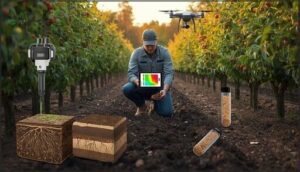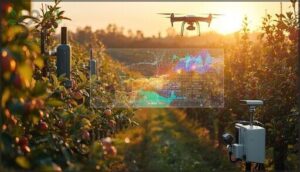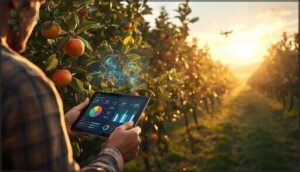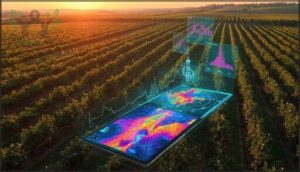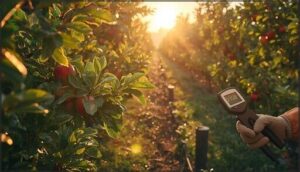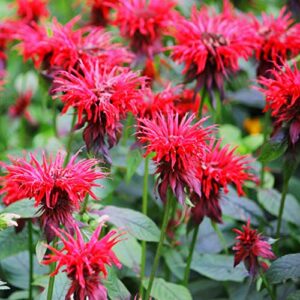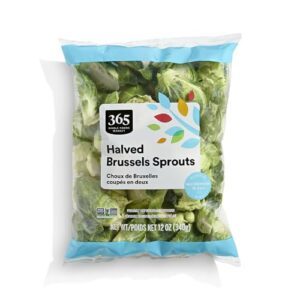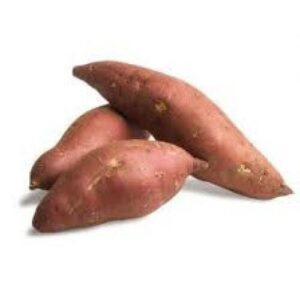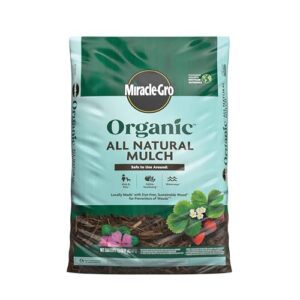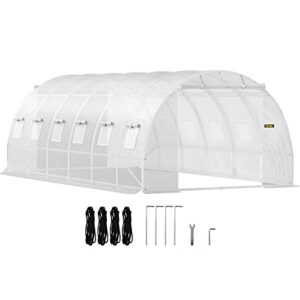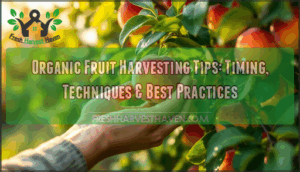This site is supported by our readers. We may earn a commission, at no cost to you, if you purchase through links.
You’ve spent months nurturing your orchard, yet harvest day reveals uneven ripening, undersized fruit, and disappointing yields that don’t reflect your effort. The frustration isn’t just about lost production—it’s watching potential slip away because traditional one-size-fits-all approaches ignore the reality that every corner of your orchard operates differently.
Soil fertility varies within meters, microclimates create temperature swings that stress trees, and generic irrigation schedules leave some zones parched while drowning others.
Maximizing fruit harvest yields demands a shift from blanket treatments to precision strategies that address the specific conditions shaping each harvest zone. When you align your management practices with the distinct needs of your soil, climate, and crop varieties, you reveal the consistent, abundant harvests your orchard can deliver.
Table Of Contents
- Key Takeaways
- Key Factors Affecting Fruit Harvest Yields
- Identifying and Managing Harvest Zones
- Precision Techniques to Boost Fruit Yields
- Sustainable and Climate-Smart Harvest Practices
- Top 10 Tools and Products for Higher Yields
- 1. Rachio Smart WiFi Sprinkler Controller
- 2. Garden Trellis for Climbing Plants
- 3. Scarlet Bee Balm Easy Grow Seeds
- 4. Fresh Halved Brussels Sprouts Pack
- 5. Bonnie Plants Early Girl Tomato
- 6. Organic Sweet Potato Delight
- 7. Organic Butternut Squash Vegetable
- 8. Garden Plant Protection Netting Cover
- 9. Natural Organic Garden Mulch Solution
- 10. Portable Walk In Greenhouse Tunnel
- Frequently Asked Questions (FAQs)
- Conclusion
Key Takeaways
- Precision zone management—tailoring irrigation, fertilization, and pest control to each orchard microclimate based on soil analysis, remote sensing, and performance data—delivers yield increases of 21-38% while cutting input costs up to 30%.
- Strategic infrastructure investments like variable-rate fertilization systems, smart irrigation controllers, and protective netting create measurable returns through reduced waste, extended growing seasons, and 26-40% reductions in weather and pest-related losses.
- Sustainable practices including organic amendments, cover cropping, and integrated pest management boost soil organic matter by up to 32% and slash pesticide costs 18-32% while building long-term climate resilience and yield stability.
- Data integration from soil sensors, weather stations, drone monitoring, and GIS mapping transforms orchards from uniform blocks into precisely managed zones where every input matches the specific conditions driving fruit quality and harvest timing.
Key Factors Affecting Fruit Harvest Yields
If you want bigger, better fruit harvests, it pays to know what really drives yield.
A few key factors can make all the difference in your orchard or garden. Here’s what you need to keep on your radar this season.
Soil Properties and Fertility
Your soil’s secret recipe—pH, organic matter, and water retention—writes the story of your harvest. Start with soil testing and analysis; these reveal composition, fertility, and subtle nutrient imbalances. Dial in nutrient management and nurture organic matter, and you’ll see boosts in soil properties, from structure to water holding.
Ideal fruit tree growth depends on sufficient soil moisture. That foundation powers vigorous fruit yields, year after year.
Microclimate Variations
Every orchard corner tells a unique weather story. Temperature gradients, humidity fluctuations, and wind patterns—all these microclimates shape fruit yield and harvest timing in ways you might overlook. Light intensity and sneaky frost pockets can make or break a crop.
Your competitive edge? Careful microclimate monitoring lets you sync cultivation with fast-changing environmental factors, maximizing every sweet, ripe harvest. Utilizing thermal sensor data can aid in identifying irrigation needs or potential diseases.
Crop Variety Selection
Just as microclimate shapes your orchard’s story, crop variety selection writes the next chapter. Hybrid advantages, dwarf varieties, and high-yield selections—these are your tools for tailoring fruit yield and quality to your goals.
Genomic selection and genetic diversity aren’t just buzzwords; they’re your insurance against unpredictable seasons, driving crop performance and climate adaptation with every planting decision you make.
Water and Nutrient Management
When your crop variety is set, it’s time to orchestrate water and nutrient management for peak fruit yield. You’ll want to:
- Monitor Deficit Irrigation and Water Quality to avoid yield losses.
- Fine-tune Fertigation Synergies for efficiency.
- Address Micronutrient Needs with regular soil analysis.
- Watch Salinity Impacts—especially when water availability drops—to keep nutrient management sharp and fruit thriving.
Pest and Disease Pressure
Picture pests as relentless rivals—always testing your resolve. Yield losses from pest pressure and disease pressure can reach 40% worldwide, with economic impact soaring into billions. Effective management strategies hinge on timely pest control, resistance management, and biological controls. Disease spread rarely mirrors neighboring crops, so specific disease management is critical.
Pests are relentless rivals that can steal 40% of your harvest unless you deploy timely, targeted control strategies
| Pest Resistance | Economic Impact |
|---|---|
| Codling moths | $1.7B saved |
| Spider mites | $92M lost |
Identifying and Managing Harvest Zones
Getting your harvest zones right can make all the difference in yield and quality. There are a handful of reliable techniques you’ll want to think about for mapping and managing these areas.
Here’s how you can pinpoint and work with your farm’s unique zones.
Soil Analysis and Mapping
How well do you know your soil? Precision Soil Sampling and high-resolution Soil Nutrient Mapping lay the groundwork for yield success. Detailed soil analysis and testing sharpen your insight into Soil Health Indicators. Leverage these five steps:
- Grid sampling
- Soil composition analysis
- Remote Sensing Accuracy validation
- Variable Rate Application planning
- Site-specific Soil management adjustments
Microclimate Monitoring Techniques
Ever wondered how harvest zones truly thrive? Remote sensing technologies in agriculture—like IoT sensors, drone monitoring, and integrated weather stations—capture real-time microclimate shifts you can’t see from ground level. With precision agriculture techniques, you’ll utilize sensor data for actionable mapping, merging weather, vision systems, and network insights for targeted actions.
| Tool/Tech | Data Tracked | Key Benefit |
|---|---|---|
| IoT Sensors | Temp, Humidity | Real-time alerting |
| Drone Monitoring | Solar, Canopy Temp | Hotspot identification |
| Weather Stations | Dew, Radiation | Optimized schedule |
Using Crop Performance Data
Imagine harnessing the power of crop performance data collection to guide every decision in your orchard. Performance data analytics, predictive yield models, and automated crop monitoring transform guesswork into strategy.
You’ll master data-driven irrigation, refine inputs, and sharpen yield improvement. Integrating yield data and analysis isn’t just a buzzword—it’s the bedrock of harvest improvement for 2025.
Remote Sensing and GIS Tools
For maximizing fruit yields, nothing rivals the precision of remote sensing and GIS software. You’re not just mapping orchard zones—you’re performing yield mapping, stress detection, quality monitoring, and resource management in real time.
With high-resolution crop monitoring and data integration, agricultural technology lets you read your land’s living map, yielding consistently better harvests.
Data Integration for Zone Delineation
Harvest zones aren’t found—they’re built, one data point at a time. You realize true orchard potential through data integration, skillfully weaving soil sensors, remote sensing, and GIS software into cohesive management zones. Focus your analysis where it counts:
- Data source fusion for richer insights
- Analytical method selection suited to your acres
- Yield outcome analysis for targeted improvement
- Spatial resolution needs for actionable delineation
Precision Techniques to Boost Fruit Yields
If you want to push your fruit yields higher, precision pays off. The right approach—timed and fitted to your orchard—can make all the difference.
Here’s how you can put sophisticated techniques to work this season.
Precision Fertilization Strategies
You’ll increase fruit yields by adopting precision fertilization strategies that match nutrient applications to your orchard’s specific needs. Variable rate fertilization (VRF) lets you target nutrient-rich areas differently from nutrient-poor zones, reducing waste by up to 30% while cutting fertilizer costs by 20%.
Refined nutrient modeling through data integration—combining soil analysis, remote sensing, and GPS-guided technology—delivers specific fertilizer management that boosts both economic benefits and environmental sustainability.
Tailored Irrigation Scheduling
Just as nutrient precision sharpens your orchard’s potential, specific irrigation scheduling unlocks water use efficiency gains exceeding 230%. You’ll improve fruit yield through sensor-based irrigation that responds to your trees’ real needs:
- Critical timing windows—flower formation through final fruit swell—deliver 21% yield increases
- Deficit irrigation strategies cut water use by 50% without sacrificing quality
- Automated scheduling with fertigation boosts returns while slashing labor costs
Precision irrigation transforms every drop into profit.
Zone-Specific Pest and Disease Control
Water precision means little if pests drain your profits zone by zone. Deploy integrated pest management with pest identification tech to map disease outbreak mapping patterns across your orchard.
Target sprays only where economic threshold benefits justify action—you’ll slash pesticide costs by 95% while protecting biological control zones.
Zone-specific pest management transforms every acre into a strategic stronghold against yield loss.
Variable Pruning and Planting Density
Beyond pest control, you’ll achieve exponential gains through variable pruning intensity and planting density adjustments. Research proves 30 cm pruning delivers 38.38 tons per hectare, while high-density systems yield 11.1 kg/m² in just 100 days.
Match pruning severity to tree vigor—aggressive cuts boost fruit quality and resource efficiency in weak zones, lighter touch preserves yield optimization where orchards thrive naturally.
Staggered Harvesting for Optimal Ripeness
When you harvest multiple times as fruits reach peak ripeness instead of clearing everything at once, you achieve dramatic yield improvements. Weekly staggered harvesting increased leaf mass over 4-fold compared to single harvest events while maintaining excellent crop quality.
- Ripeness indicators like firmness and sugar content guide best harvest timing for each interval
- Labor management spreads workforce demands evenly, avoiding costly peak-season crunches
- Market demand alignment through harvest planning stabilizes prices and ensures storage optimization
This harvest optimization strategy reduces total crop failure risk while delivering consistently excellent fruit ripeness.
Sustainable and Climate-Smart Harvest Practices
Fruit production’s outlook isn’t just about maximizing yields today—it’s about securing harvests for decades to come. Climate volatility and resource constraints are reshaping how you’ll need to approach orchard management, making sustainability not optional but essential.
Here are five climate-smart practices that’ll help you build resilience while maintaining productivity in your harvest zones.
Crop Rotation and Cover Cropping
Think of crop rotation as your orchard’s insurance policy against yield collapse. By rotating fruit crops with legumes and cover crops, you’ll boost soil health by up to 32% in organic matter and cut pest suppression challenges dramatically.
This sustainable agriculture practice delivers yield stability—studies show 20–48% higher crop yields while building climate resilience through enhanced water conservation and nutrient cycling.
Mulching and Organic Soil Amendments
Layering mulch and organic amendments onto your orchard floor unlocks soil health transformations that directly translate to heavier fruit yields. Woodchip mulch alone can boost fresh-marketable tomato production by 16–57%, while organic matter enriches nutrient dynamics and water retention. These soil management practices deliver economic benefits through reduced irrigation costs and improved fruit quality.
- Mulch yield effects: Polyethylene treatments produced experimental yields up to 2.67 tons per hectare
- Soil fertility gains: Compost applications increase macro- and micronutrient availability critical for fruiting
- Enhanced water retention: Mulching reduces evaporation, supporting sustainable gardening even in water-limited environments
Adaptive Strategies for Climate Change
Climate change and fruit farming demand swift, science-backed action—your orchard’s future depends on adaptive management plans that merge resistant crop varieties with agro-tech interventions. You’ll secure yields through precision agriculture, climate-smart gardening, and refined agronomic practices that counter environmental factors head-on.
| Strategy Category | Key Interventions |
|---|---|
| Resistant Crop Varieties | Low-chill apples, drought-tolerant pomegranates (15–25% yield gains) |
| Agro-Tech Interventions | Shade nets, sensors, chitosan sprays (12–40% efficiency boost) |
| Economic Adaptations | Crop insurance uptake (+28%), off-farm diversification (+21%) |
| Precision Agriculture | Variable irrigation, drone monitoring (18–37% productivity lift) |
Efficient Harvesting and Storage Methods
You can slash postharvest losses—currently running between 20% and 50% globally—by mastering harvest timing and deploying storage technologies that extend shelf life while maintaining fruit quality. Cooling techniques like vacuum cooling reduce respiration rates by two- to threefold, and mechanized systems now achieve 95% activity accuracy in commercial operations, unlocking genuine harvest optimization.
- Choose harvest tools and training systems that minimize fruit damage and boost picker efficiency beyond 75%
- Apply rapid cooling immediately after harvest; vacuum methods deliver three times the energy efficiency of blast chilling
- Store non-chilling-sensitive fruits just above freezing and tropical varieties at 7–15°C for maximum longevity
- Implement controlled atmosphere protocols with reduced oxygen and elevated CO₂ to slow aging
- Track runtime efficiency and machine productivity metrics to improve harvesting and storage workflows season over season
Integrated Pest Management Approaches
You’ll cut pesticide costs by 18–32% when you adopt IPM strategies that blend biological controls, targeted scouting, and eco-friendly practices customized to each harvest zone.
Weekly crop monitoring across 2,250+ acres in 2024 proved that pheromone traps and natural predators slash pest pressure by up to 77%, while zone-specific pest management keeps beneficial insects thriving and yields climbing.
Top 10 Tools and Products for Higher Yields
You can’t control the weather, but you can absolutely control the tools you use to enhance every stage of fruit production. The right equipment turns guesswork into precision, helping you manage irrigation, extend growing seasons, and protect your crops from environmental stress.
Here are ten proven tools that’ll give you a measurable edge in maximizing your harvest yields this season.
1. Rachio Smart WiFi Sprinkler Controller
You’ll achieve exceptional water efficiency and crop optimization with the Rachio Smart WiFi Sprinkler Controller, a precision farming tool engineered for adaptive irrigation across harvest zones.
This controller integrates weather data and soil moisture sensors to automate watering and irrigation schedules, delivering up to 52% water savings while boosting fruit yields by 21% in field trials.
Its app-based scheduling lets you manage up to 16 zones remotely, adjusting irrigation precisely for each microclimate zone—essential for sustainable agriculture and maximizing packout quality.
Best For: Fruit growers and orchard managers looking to maximize water efficiency, increase crop yields, and automate irrigation scheduling with precision control across multiple zones.
- Cuts water use by up to 52% through automatic weather-based adjustments and smart scheduling, which can significantly lower utility costs while improving plant health.
- Boosts fruit yield and quality by up to 21% with precision irrigation that responds to real-time soil and environmental conditions, leading to better harvests and higher returns.
- Manages up to 16 zones remotely through an easy-to-use app, making it simple to customize watering for different microclimates and crop needs from anywhere.
- Some users report WiFi connectivity issues that can disrupt remote monitoring and control, especially in areas with weak signal strength.
- May need extra equipment or setup modifications for well systems, external pumps, or properties with multiple master valves, adding to installation complexity.
- Not compatible with non-US power standards without adapters, and firmware updates or technical troubleshooting may occasionally be required to maintain optimal performance.
2. Garden Trellis for Climbing Plants
You’ll capture up to 120% more fruit per square meter by implementing vertical gardening with a well-designed trellis system for climbing structures.
Garden trellises enhance fruit cultivation through strategic plant training—keeping vines off the soil reduces disease pressure while improving air circulation and light penetration.
This 63” x 63” polyethylene-coated steel frame assists climbing vegetables and fruits with adjustable width for small space gardening.
Proper pruning techniques combined with trellis design improve canopy structure, facilitating easier harvesting while maximizing your available growing area and yield potential per plant.
Best For: Gardeners looking to maximize small spaces with vertical growing systems for climbing vegetables, fruits, and flowers while reducing disease issues and improving harvest accessibility.
- Proven to increase yields significantly—trellised systems can produce up to 120% more fruit per square meter compared to ground planting by maximizing vertical space and improving light exposure.
- Reduces disease and pest problems by keeping plants off the soil, which improves air circulation around foliage and minimizes fungal issues like powdery mildew and fruit rot.
- Makes harvesting easier and less labor-intensive since fruits hang at accessible heights, reducing crop damage and physical strain during collection.
- Durability concerns with plastic joints and clips that may crack or break over time, potentially requiring repairs or replacements during the growing season.
- May need additional reinforcement for heavier plants or in areas with strong winds, as the lightweight construction might not support very vigorous climbers without modification.
- Some quality control issues reported by customers, including missing parts upon delivery or components that don’t fit together properly during assembly.
3. Scarlet Bee Balm Easy Grow Seeds
Beyond structural support, you’ll increase fruit production through enhanced pollination. Scarlet Bee Balm’s 250 heirloom seeds deliver vibrant red blooms that attract hummingbirds, bees, and butterflies to your garden ecosystem.
These mint-scented perennials thrive in USDA Zones 4-9, germinating within 14-21 days when surface-sown with light exposure. Their deer resistance and culinary uses (edible leaves for teas) complement garden aesthetics while boosting pollinator activity during critical fruit set periods.
Proper seed germination requires maintaining temperatures above 55°F and ensuring adequate spacing—12 to 24 inches—for peak airflow and harvest timing coordination.
Best For: Gardeners in zones 4-9 who want to attract pollinators like hummingbirds and bees while growing a dual-purpose plant with edible leaves for teas and vibrant red blooms for cut arrangements.
- Attracts a wide range of pollinators including hummingbirds, bees, and butterflies, making it excellent for supporting garden biodiversity and improving pollination of nearby fruiting plants.
- Edible and aromatic with mint-scented leaves that work well in teas, potpourri, and cooking, plus the flowers make beautiful cut arrangements.
- Deer resistant and hardy across a wide range of climates (zones 4-9), spreading naturally through rhizomes to form attractive colonies with minimal maintenance once established.
- Germination is inconsistent with some customers reporting mixed success rates, unhealthy seedlings, or seeds that never sprouted despite following instructions.
- Prone to seed loss before harvest due to loose-fitting seeds that easily fall out from wind, storms, or birds, reducing overall seed yield compared to other varieties.
- Requires specific growing conditions like cold stratification for 2-4 weeks, surface sowing with light exposure, and careful spacing to prevent powdery mildew, making it less beginner-friendly than some perennials.
4. Fresh Halved Brussels Sprouts Pack
While pollinators energize your garden’s productivity, post-harvest handling determines what reaches your table. The Fresh Halved Brussels Sprouts Pack—sourced at California’s peak harvest timing—exemplifies market demand for convenience without sacrificing freshness maintenance.
Pre-halved packaging extends shelf-life to ten days under refrigeration, addressing production challenges of field-to-fork efficiency.
You’ll notice these halved sprout benefits translate directly to fruit yield principles: proper harvest time coordination, temperature control, and minimized handling stress boost crop yields whether you’re harvesting fruit or brassicas.
Best For: People who want ready-to-cook Brussels sprouts without the prep work, especially if you’re roasting, sautéing, or adding them to salads and mixed dishes.
- Already halved so you can skip the chopping and go straight to cooking, saving time on busy weeknights.
- Stays fresh for up to 10 days in the fridge when stored properly, giving you flexibility on when to use them.
- Sourced from quality growing regions like California, where conditions produce reliable, flavorful sprouts.
- You still need to wash them before eating, so it’s not completely zero-prep.
- The 12-ounce package might be too small if you’re cooking for a larger group or meal prepping for the week.
- At $3.49, the convenience factor adds to the cost compared to buying whole sprouts and cutting them yourself.
5. Bonnie Plants Early Girl Tomato
Vertical staking transforms your Early Girl tomato’s indeterminate growth into a yield powerhouse—under ideal conditions, you’re looking at 300 tomatoes per plant throughout the season. This hybrid’s disease resistance to verticillium and fusarium wilt races 1 and 2 reduces crop losses while its 50-day maturity accelerates harvest timing.
Pair full sun exposure with drip irrigation and balanced fertilization to boost fruit yield.
Your soil management directly impacts those 4-to-8-ounce fruits: amend with compost pre-planting, mulch for moisture retention, and watch your crop yields soar from early summer through frost.
Best For: Home gardeners who want early harvests and continuous production throughout the summer, especially those in zones 3-9 looking for a disease-resistant, high-yielding tomato that’s great for slicing and fresh eating.
- Impressive yield potential of up to 300 tomatoes per plant under ideal conditions, with consistent 4-to-8-ounce fruits from early summer through frost
- Strong disease resistance to verticillium and fusarium wilt (races 1 and 2), reducing crop losses and maintenance hassles
- Fast 50-day maturity means you get that first fresh tomato of the season earlier than most varieties, plus you can plant again in late summer for a fall harvest
- Plant health and condition can be inconsistent upon delivery, with some customers receiving dried-out or smaller-than-expected plants
- Requires significant support structures like tall cages or stakes since the indeterminate vines grow over 4 feet tall
- Needs consistent watering and careful moisture management to avoid issues like blossom end rot, making it less forgiving for hands-off gardeners
6. Organic Sweet Potato Delight
Organic varieties like these Jewel yams deliver sweet potato benefits you can’t ignore—up to 600 lbs per 100 ft bed when you nail soil health between pH 5.8 and 6.0. Your harvest timing hinges on well-drained sandy loam and split nitrogen applications that minimize leaching.
Storage methods matter: temperature-controlled environments extend shelf life, though texture issues arise if tubers sit too long.
Recipe ideas abound—roast, mash, or bake these beta-carotene powerhouses while practicing organic gardening methods.
Integrate pest management with biological controls to protect your fruit yield and increase returns per acre.
Best For: Home cooks and gardeners who want organic, nutrient-rich sweet potatoes for everything from healthy snacks to complex recipes, and don’t mind paying a bit more for quality produce.
- Packed with beta-carotene and fiber, making them a genuinely healthy choice whether you’re snacking or cooking.
- Super versatile in the kitchen—you can roast them, mash them, bake them, or turn them into fries and sweet dishes.
- Sourced and stored with high organic standards, so you’re getting fresh produce that’s been handled properly from farm to table.
- Some customers think they’re too large, which can be inconvenient if you’re cooking for one or two people.
- Shelf life can be hit or miss—they may get stringy or spoil faster than expected if storage conditions aren’t perfect.
- Price point is higher than conventional sweet potatoes, which might not work for everyone’s grocery budget.
7. Organic Butternut Squash Vegetable
You’ll push marketable yields to 285 bushels per acre when you master nutrient management for this organic squash—nitrogen rates between 50 and 100 lb/acre deliver peak performance without crossing the 150 lb/acre toxicity threshold.
Harvest practices demand stem retention of 1 to 5 inches to extend storage life and preserve market value exceeding $204 million annually.
Integrated pest control using diatomaceous earth and neem oil protects against squash bugs while maintaining soil health through organic gardening methods that fruit vegetable gardening enthusiasts rely on for consistent returns.
Best For: Home gardeners and small-scale organic farmers looking to grow a nutrient-dense, versatile fall crop with strong market demand and good storage potential.
- High yield potential of up to 285 bushels per acre when managed with optimal nitrogen levels (50-100 lb/acre), making it economically viable for organic production.
- Packed with essential nutrients including vitamin A, vitamin C, fiber, and antioxidants at only 48 calories per 100g serving, appealing to health-conscious consumers.
- Excellent storage capability lasting several months when harvested properly with intact stems, reducing post-harvest losses and extending sales windows.
- Requires precise nutrient management since nitrogen applications above 150 lb/acre can reduce yields, demanding careful soil monitoring and fertilizer planning.
- Vulnerable to persistent pests like squash bugs and vine borers that need ongoing organic control measures including neem oil treatments and physical barriers.
- Long maturity period of 80-120 days from planting to harvest ties up garden space and delays returns compared to faster-growing vegetables.
8. Garden Plant Protection Netting Cover
You’ll secure ultra-fine mesh (0.8 mm x 1 mm) that delivers outstanding pest exclusion efficacy against birds, caterpillars, and fruit flies while allowing critical pollination management through strategic access points.
Netting material durability extends 3-5 years with UV-resistant PE construction, creating microclimate modification that reduces sunburn damage on fruit trees by 6-10°F and boosts fruit yield up to 26.3% in shade-optimized systems.
Integrate sustainable netting options with pest management strategies—anchor edges tightly to block wildlife, monitor trapped populations weekly, and time removals during peak pollination for harvesting fruit at premium quality without chemical interventions.
Best For: Gardeners who want to protect their crops from birds, insects, and wildlife while maintaining healthy growing conditions without using chemical pesticides.
- Ultra-fine 0.8mm x 1mm mesh effectively blocks most pests including birds, caterpillars, and fruit flies while still allowing sunlight, rain, and air circulation for healthy plant growth.
- Creates a beneficial microclimate that can increase yields up to 26% and provides frost protection of 6-10°F, extending your growing season and improving fruit quality.
- Durable UV-resistant PE material lasts 3-5 years and can be reused season after season, making it a cost-effective long-term solution that’s better for the environment than repeated pesticide applications.
- Requires secure anchoring and proper installation to prevent wind damage, and may need additional support clips that can create small holes in the material over time.
- Can limit access for beneficial pollinators during flowering, so you’ll need to manage it carefully by creating strategic openings or removing it temporarily during peak pollination periods.
- The fine mesh can be difficult to see through in bright sunlight and some users report the material may rip or fray with frequent handling, especially at anchor points.
9. Natural Organic Garden Mulch Solution
You’ll utilize organic garden mulch to transform soil fertility and moisture retention while delivering powerful weed suppression across your fruit production zones. Applied at 0.25 kg/m², organic mulch boosts soil infiltration by up to 77.4% and elevates soil organic carbon by 29% within six months—driving nutrient cycling that directly amplifies fruit yield.
Market trends show organic mulch commanding 55.2% of revenue in 2024, reflecting its proven role in organic farming and integrated pest control. Strategic soil preparation with natural mulch gives you command over soil quality while safeguarding long-term productivity.
Best For: Organic farmers and home gardeners who want to boost soil health, cut down on weeding time, and improve fruit yields without synthetic chemicals.
- Increases soil organic carbon by up to 29% in six months and raises nitrogen levels by 16%, creating healthier, more fertile soil that supports stronger plant growth and better harvests.
- Dramatically improves water efficiency by boosting soil infiltration up to 77% and reducing runoff by nearly 25%, which means less frequent watering and better moisture retention during dry spells.
- Delivers natural weed suppression when applied in a 3-inch layer while attracting beneficial insects that help control pests like aphids, reducing your need for additional interventions.
- Takes considerable time to absorb water initially, which can slow down setup and may require pre-soaking before application in some cases.
- Cannot be used around young seedlings or underdeveloped plants, and must be kept away from tree trunks and building foundations to prevent moisture damage.
- Individual packaging creates extra waste, and achieving proper 3-inch coverage depth requires multiple boxes for larger garden areas, increasing both cost and material handling.
10. Portable Walk In Greenhouse Tunnel
You’ll command season extension and microclimate control with a portable walk-in greenhouse tunnel that increases fruit yield by up to 30% compared to open-field cultivation. The 20 x 10 x 7 ft galvanized steel structure delivers improved pest management through 12 mesh windows while enabling climate adaptation strategies that reduce weather-related losses by 40%.
Though aphid populations may rise 25% inside tunnels, you’ll achieve maximum yield through extended harvesting seasons and enhanced fruit production stability.
With the global tunnel market reaching $7.8 billion by 2032, this reflects a proven economic impact.
Best For: Growers who want to extend their growing season and boost fruit yields by up to 30% while protecting crops from weather damage and pests.
- Strong galvanized steel frame with excellent ventilation through 12 mesh windows and 2 roll-up doors keeps plants healthy and increases airflow.
- Reduces weather-related crop losses by 40% with waterproof PE cover that protects against UV rays, rain, and snow while allowing nearly year-round harvesting.
- Easy assembly with included tools and stakes, plus the portable design lets you move it seasonally or rotate crops to prevent pest buildup.
- Aphid and whitefly populations can increase by up to 25% inside the enclosed space, so you’ll need to stay on top of pest management.
- Zippers and seams tend to wear out quickly, and the PE cover may need replacement after a year or two due to dry rot or damage.
- The included stakes and tie-downs might not hold up well in high winds or heavy storms, so you may need extra reinforcement in harsh weather areas.
Frequently Asked Questions (FAQs)
How does pollination timing affect fruit size?
Pollination timing directly influences fruit size through pollen tube growth rates and hormonal signaling pathways. Early morning pollination—between 8:00 and 10:00 am—consistently produces larger fruits with higher seed numbers, optimizing crop yield.
What role do beneficial insects play?
Beneficial insects are absolute game-changers for your orchard. They drive pollination efficiency and pest reduction, boosting fruit quality by up to 23% while slashing damage over 50%.
Integrated pest management and habitat management strategies preserve this biodiversity, enhancing garden ecosystem health, ecological balance, and economic value through pollination services and natural biocontrol.
Can companion planting increase harvest yields?
Yes—companion planting can dramatically boost your fruit yields. Strawberries paired with borage achieved 32% higher total harvest weight.
Pollinator attraction, pest suppression, and nutrient enhancement from diverse plantings improve crop performance across garden ecosystems.
How often should soil pH be tested?
You should test soil pH every 3–5 years for perennial fruit production, more frequently for sandy soils (2–3 years) or high-value operations.
Regular monitoring detects trends early, guiding timely fertilization and nutrient management adjustments.
Do moonlight cycles influence fruit ripening rates?
While ancient lunar farming practices promise ripening synchronicity, peer-reviewed field trials remain limited.
Full moonlight alters plant biology—boosting sugars and metabolites tied to fruit maturity—yet substantial evidence linking moon phases directly to harvest time needs expansion.
Conclusion
Your orchard doesn’t yield inconsistency by accident—it yields what you measure, manage, and improve. Zone-specific fertility, specific irrigation, adaptive pest control: these aren’t optional refinements but essential levers for maximizing fruit harvest yields in 2025 and beyond.
The tools exist, the data awaits, and the techniques deliver when applied with precision. Stop managing your orchard as uniform ground. Start treating each zone as the distinct ecosystem it is, and watch potential become performance.
- https://pmc.ncbi.nlm.nih.gov/articles/PMC5428234/
- https://farmonaut.com/precision-farming/ai-for-harvest-optimization-7-shocking-crop-boost-hacks
- https://www.frontiersin.org/journals/computer-science/articles/10.3389/fcomp.2025.1567333/full
- https://www.sciencedirect.com/science/article/pii/S0168169925003187
- https://www.yesearth.org/2025/09/22/effects-of-climate-change-on-fruit-production-a-comprehensive-review/


